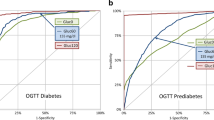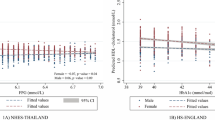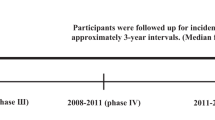Abstract
Elevated 2-h plasma glucose concentration (2hPG) from an oral glucose tolerance (OGTT) test more strongly predicts risk of subsequent cardiovascular disease than fasting plasma glucose (FPG), but the association between these glucose measurements and hypertension risk is less clear. We examined the association between 2hPG, FPG and risk of hypertension. We conducted a prospective observational study (The Australian Diabetes, Obesity and Lifestyle Study—AusDiab) among 4413 Australian residents who attended a baseline (1999–2000) and follow-up (2004–2005) examinations. Measurements included blood pressure (mean of two readings), 75 g OGTT, fasting insulin, anthropometrics, dietary and alcohol intake, medical history and physical activity. Hypertension was defined as a systolic blood pressure (SBP)⩾140 or a diastolic blood pressure (DBP)⩾90 mm Hg or treatment with medication for hypertension. HOMA-S was calculated as a measure of insulin sensitivity using the HOMA2 calculator. Hypertension developed in 14% of the 4306 subjects available for this analysis. Higher 2hPG was significantly related to greater risk of hypertension after adjustment for age, gender, FPG, BMI (baseline and difference), waist circumference (baseline and difference), education, exercise, alcohol intake, baseline SBP and smoking (OR (95% CI) 1.12 (1.01 to 1.23)), but no significant association was seen between FPG and hypertension in this model (1.02 (0.88–1.19)). Further adjustment for HOMA-S did not change these findings. Higher baseline 2hPG was more strongly associated with an increase in SBP than in DBP over 5 years. We conclude that higher 2hPG predicted future hypertension occurrence in this population.
This is a preview of subscription content, access via your institution
Access options
Subscribe to this journal
Receive 12 digital issues and online access to articles
$119.00 per year
only $9.92 per issue
Buy this article
- Purchase on Springer Link
- Instant access to full article PDF
Prices may be subject to local taxes which are calculated during checkout

Similar content being viewed by others
References
Qiao Q, Jousilahti P, Eriksson J, Tuomilehto J . Predictive properties of impaired glucose tolerance for cardiovascular risk are not explained by the development of overt diabetes during follow-up. Diabetes Care 2003; 26: 2910–2914.
Stamler J, Vaccaro O, Neaton JD, Wentworth D . Diabetes, other risk factors, and 12-yr cardiovascular mortality for men screened in the multiple risk factor intervention trial. Diabetes Care 1993; 16: 434–444.
Glucose Tolerance and Cardiovascular Mortality. Comparison of fasting and 2-h diagnostic criteria. Arch Intern Med 2001; 161: 397–405.
Coutinho M, Gerstein HC, Wang Y, Yusuf S . The relationship between glucose and incident cardiovascular events. A metaregression analysis of published data from 20 studies of 95 783 individuals followed for 12.4 years. Diabetes Care 1999; 22: 233–240.
Shaw JE, Hodge AM, de Courten M, Chitson P, Zimmet PZ . Isolated post-challenge hyperglycaemia confirmed as a risk factor for mortality. Diabetologia 1999; 42: 1050–1054.
Chiasson JL, Josse RG, Gomis R, Hanefeld M, Karasik A, Laakso M . Acarbose treatment and the risk of cardiovascular disease and hypertension in patients with impaired glucose tolerance: the stop-niddm trial. JAMA 2003; 290: 486–494.
Fagot-Campagna A, Balkau B, Simon D, Ducimetiere P, Eschwege E . Is insulin an independent risk factor for hypertension? The Paris Prospective Study. Int J Epidemiol 1997; 26: 542–550.
Haffner SM, Valdez R, Morales PA, Mitchell BD, Hazuda HP, Stern MP . Greater effect of glycemia on incidence of hypertension in women than in men. Diabetes Care 1992; 15: 1277–1284.
Suematsu C, Hayashi T, Fujii S, Endo G, Tsumura K, Okada K et al. Impaired fasting glucose and the risk of hypertension in Japanese men between the 1980s and the 1990s. The Osaka health survey. Diabetes Care 1999; 22: 228–232.
Vaccaro O, Imperatore G, Iovino V, Iovine C, Rivellese AA, Riccardi G . Does impaired glucose tolerance predict hypertension? A prospective analysis. Diabetologia 1996; 39: 70–76.
Wang W, Lee ET, Fabsitz RR, Devereux R, Best L, Welty TK et al. A longitudinal study of hypertension risk factors and their relation to cardiovascular disease: the Strong Heart Study. Hypertension 2006; 47: 403–409.
Hayashi T, Boyko EJ, Leonetti DL, McNeely MJ, Newell-Morris L, Kahn SE et al. Visceral adiposity is an independent predictor of incident hypertension in Japanese Americans. Ann Intern Med 2004; 140: 992–1000.
Rothman KJ, Greenland S . Causation and causal inference in epidemiology. Am J Public Health 2005; 95 (Suppl 1): S144–S150.
Cameron AJ, Welborn TA, Zimmet PZ, Dunstan DW, Owen N, Salmon J et al. Overweight and obesity in Australia: the 1999–2000 Australian Diabetes, Obesity and Lifestyle Study (AusDiab). Med J Aust 2003; 178: 427–432.
Dunstan DW, Zimmet PZ, Welborn TA, Cameron AJ, Shaw J, de Courten M et al. The Australian Diabetes, Obesity and Lifestyle Study (AusDiab)—methods and response rates. Diabetes Res Clin Pract 2002; 57: 119–129.
Dunstan DW, Zimmet PZ, Welborn TA, De Courten MP, Cameron AJ, Sicree RA et al. The rising prevalence of diabetes and impaired glucose tolerance: the Australian Diabetes, Obesity and Lifestyle study. Diabetes Care 2002; 25: 829–834.
Australian Institute of Health and Welfare (AIHW). The Active Australia Survey: A Guide and Manual for Implementation, Analysis, and Reporting. Australian Institute of Health and Welfare: Canberra, 2003.
Ireland P, Jolley D, Giles G, O'Dea K, Powles J, Rutishauser I et al. Development of the Melbourne ffq: a food frequency questionnaire for use in an Australian Prospective Study involving an ethnically diverse cohort. Asia Pac J Clin Nutr 1994; 3: 19–31.
Lewis J, Milligan G, Hunt A . Nuttab95 Nutrient Data Table for use in Australia. Australian Government Publishing Service: Canberra, Australia, 1995.
Dunstan DW, Salmon J, Owen N, Armstrong T, Zimmet PZ, Welborn TA et al. Associations of tv viewing and physical activity with the metabolic syndrome in Australian adults. Diabetologia 2005; 48: 2254–2261.
Briganti EM, Shaw JE, Chadban SJ, Zimmet PZ, Welborn TA, McNeil JJ et al. Untreated hypertension among Australian adults: the 1999–2000 Australian Diabetes, Obesity and Lifestyle Study (AusDiab). Med J Aust 2003; 179: 135–139.
World Health Organization. Definitions, Diagnosis, and Classifications of Diabetes Mellitus and Its Complications. World Health Organization: Geneva, 1999.
Wallace TM, Levy JC, Matthews DR . Use and abuse of homa modeling. Diabetes Care 2004; 27: 1487–1495.
Dalton M, Cameron AJ, Zimmet PZ, Shaw JE, Jolley D, Dunstan DW et al. Waist circumference, waist-hip ratio and body mass index and their correlation with cardiovascular disease risk factors in Australian adults. J Intern Med 2003; 254: 555–563.
Long J, Freese J . Regression Models for Categorical Dependent Variables Using Stata. Stata Corporation: College Station, 2001.
Vickers AJ, Altman DG . Statistics notes: analysing controlled trials with baseline and follow up measurements. BMJ 2001; 323: 1123–1124.
Cleveland WS . Robust locally weighted regression and smoothing analysis. J Am Stat Assoc 1979; 74: 829–836.
Vittinghoff E, McCulloch CE . Relaxing the rule of ten events per variable in logistic and cox regression. Am J Epidemiol 2007; 165: 710–718.
Knowler WC, Barrett-Connor E, Fowler SE, Hamman RF, Lachin JM, Walker EA et al. Reduction in the incidence of type 2 diabetes with lifestyle intervention or metformin. N Engl J Med 2002; 346: 393–403.
Ratner R, Goldberg R, Haffner S, Marcovina S, Orchard T, Fowler S et al. Impact of intensive lifestyle and metformin therapy on cardiovascular disease risk factors in the diabetes prevention program. Diabetes Care 2005; 28: 888–894.
Kirpichnikov D, McFarlane SI, Sowers JR . Metformin: an update. Ann Intern Med 2002; 137: 25–33.
Meyer C, Pimenta W, Woerle HJ, Van Haeften T, Szoke E, Mitrakou A et al. Different mechanisms for impaired fasting glucose and impaired postprandial glucose tolerance in humans. Diabetes Care 2006; 29: 1909–1914.
Ceriello A, Davidson J, Hanefeld M, Leiter L, Monnier L, Owens D et al. Postprandial hyperglycaemia and cardiovascular complications of diabetes: an update. Nutr Metab Cardiovasc Dis 2006; 16: 453–456.
Ceriello A, Quatraro A, Giugliano D . Diabetes mellitus and hypertension: the possible role of hyperglycaemia through oxidative stress. Diabetologia 1993; 36: 265–266.
Title LM, Cummings PM, Giddens K, Nassar BA . Oral glucose loading acutely attenuates endothelium-dependent vasodilation in healthy adults without diabetes: an effect prevented by vitamins c and e. J Am Coll Cardiol 2000; 36: 2185–2191.
Williams SB, Goldfine AB, Timimi FK, Ting HH, Roddy MA, Simonson DC et al. Acute hyperglycemia attenuates endothelium-dependent vasodilation in humans in vivo. Circulation 1998; 97: 1695–1701.
Ferrannini E, Buzzigoli G, Bonadonna R, Giorico MA, Oleggini M, Graziadei L et al. Insulin resistance in essential hypertension. N Engl J Med 1987; 317: 350–357.
Leiter LA, Ceriello A, Davidson JA, Hanefeld M, Monnier L, Owens DR et al. Postprandial glucose regulation: new data and new implications. Clin Ther 2005; 27 (Suppl 2): S42–S56.
Svatikova A, Wolk R, Gami AS, Pohanka M, Somers VK . Interactions between obstructive sleep apnea and the metabolic syndrome. Curr Diab Rep 2005; 5: 53–58.
Kristman V, Manno M, Cote P . Loss to follow-up in cohort studies: how much is too much? Eur J Epidemiol 2004; 19: 751–760.
Ko GT, Chan JC, Woo J, Lau E, Yeung VT, Chow CC et al. The reproducibility and usefulness of the oral glucose tolerance test in screening for diabetes and other cardiovascular risk factors. Ann Clin Biochem 1998; 35 (Part 1): 62–67.
Armstrong BG . Effect of measurement error on epidemiological studies of environmental and occupational exposures. Occup Environ Med 1998; 55: 651–656.
Vasan RS, Beiser A, Seshadri S, Larson MG, Kannel WB, D'Agostino RB et al. Residual lifetime risk for developing hypertension in middle-aged women and men: the Framingham Heart Study. JAMA 2002; 287: 1003–1010.
Acknowledgements
The AusDiab study is supported by a National Health and Medical Research Council (NHMRC) project grant (233200). ELMB is supported by an NHMRC (379305)/National Heart Foundation (PP 05M 2346) joint postgraduate scholarship.
We also acknowledge the generous support given by the following: the Australian Government Department of Health and Ageing. Abbott Australasia Pty Ltd, Alphapharm Pty Ltd, AstraZeneca, Bayer HealthCare AG, Bristol-Myers Squibb, City Health Centre-Diabetes Service-Canberra, Department of Health and Community Services—Northern Territory, Department of Health and Human Services—Tasmania, Department of Health—New South Wales, Department of Health—Western Australia, Department of Health—South Australia, Department of Human Services—Victoria, Diabetes Australia, Diabetes Australia Northern Territory, Eli Lilly Australia, Estate of the Late Edward Wilson, GlaxoSmithKline, Jack Brockhoff Foundation, Janssen-Cilag, Kidney Health Australia, Marian & FH Flack Trust, Menzies Research Institute, Merck Sharp & Dohme, Novartis Pharmaceuticals, Novo Nordisk Pharmaceuticals, Pfizer Pty Ltd, Pratt Foundation, Queensland Health, Roche Diagnostics Australia, Royal Prince Alfred Hospital, Sydney, Sanofi Synthelabo and Sanofi Aventis. Also, for their invaluable contribution to the set-up and field activities of AusDiab, we are enormously grateful to A Allman, B Atkins, S Bennett, A Bonney, S Chadban, M de Courten, M Dalton, D Dunstan, T Dwyer, H Jahangir, D Jolley, D McCarty, A Meehan, N Meinig, S Murray, K O'Dea, K Polkinghome, P Phillips, C Reid, A Stewart, R Tapp, H Taylor, T Whalen and F Wilson.
Author information
Authors and Affiliations
Corresponding author
Additional information
Conflict of Interest: None
Rights and permissions
About this article
Cite this article
Boyko, E., Barr, E., Zimmet, P. et al. Two-hour glucose predicts the development of hypertension over 5 years: the AusDiab study. J Hum Hypertens 22, 168–176 (2008). https://doi.org/10.1038/sj.jhh.1002316
Received:
Revised:
Accepted:
Published:
Issue Date:
DOI: https://doi.org/10.1038/sj.jhh.1002316
Keywords
This article is cited by
-
Fasting Blood Glucose and 2-h Postprandial Blood Glucose Predict Hypertension: A Report from the REACTION Study
Diabetes Therapy (2021)
-
Glucose and the risk of hypertension in first-degree relatives of patients with type 2 diabetes
Hypertension Research (2015)
-
Fasting glucose and HbA1c levels as risk factors for the development of hypertension in Japanese individuals: Toranomon hospital health management center study 16 (TOPICS 16)
Journal of Human Hypertension (2015)
-
Impaired fasting glucose as an independent risk factor for hypertension among healthy middle-aged Japanese subjects with optimal blood pressure: the Yuport Medical Checkup Centre retrospective cohort study
Diabetology & Metabolic Syndrome (2013)
-
Insulin resistance in young, lean male subjects with essential hypertension
Journal of Human Hypertension (2011)



